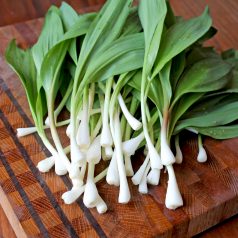
Ramp Pesto
Happy ramp season! Ramps, allium tricoccum, are wild leeks that can be found in wet, densely wooded areas through central and eastern US and Canada. They grow in dense clusters in marshy areas and around rivers, streams, and brooks. They thrive in early spring when the leaves of the forest canopy are thin, allowing light to pass through to the forest floor. They can be identified by their broad, smooth, green leaves and their garlic-like aroma. Their taste can be described as a pungent mix between a green onion and garlic. Ramps are extremely sensitive to over-harvesting and habitat disturbance so, when harvesting ramps in the wild, please do so responsibly: tread lightly; move often, never harvesting more than a few ramps from each cluster; and harvest from the center of each cluster rather than from the outskirts. The ramps can repopulate an area in the center of a cluster more easily than they can from the outer edges. Of course, if you’d prefer to purchase your ramps, you can find them in our produce department during their brief & fleeting season!
Wondering what to do with them? Check out this fresh, simple ramp pesto recipe. It makes a delicious spread on crusty bread, a perfect add-in to your favorite hot or cold pasta dish, a flavorful pizza topping, or a tasty chicken marinade.

